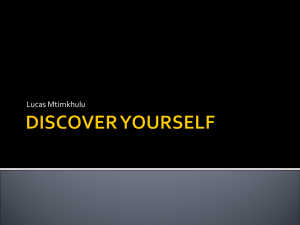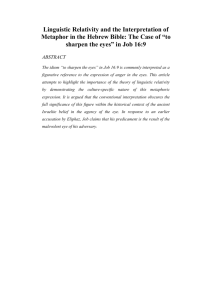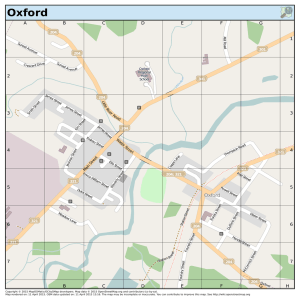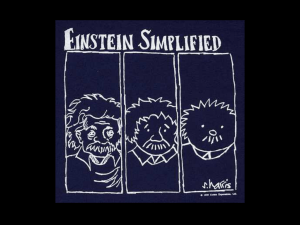Instructions to Authors for A4: 21 - IS MU
advertisement
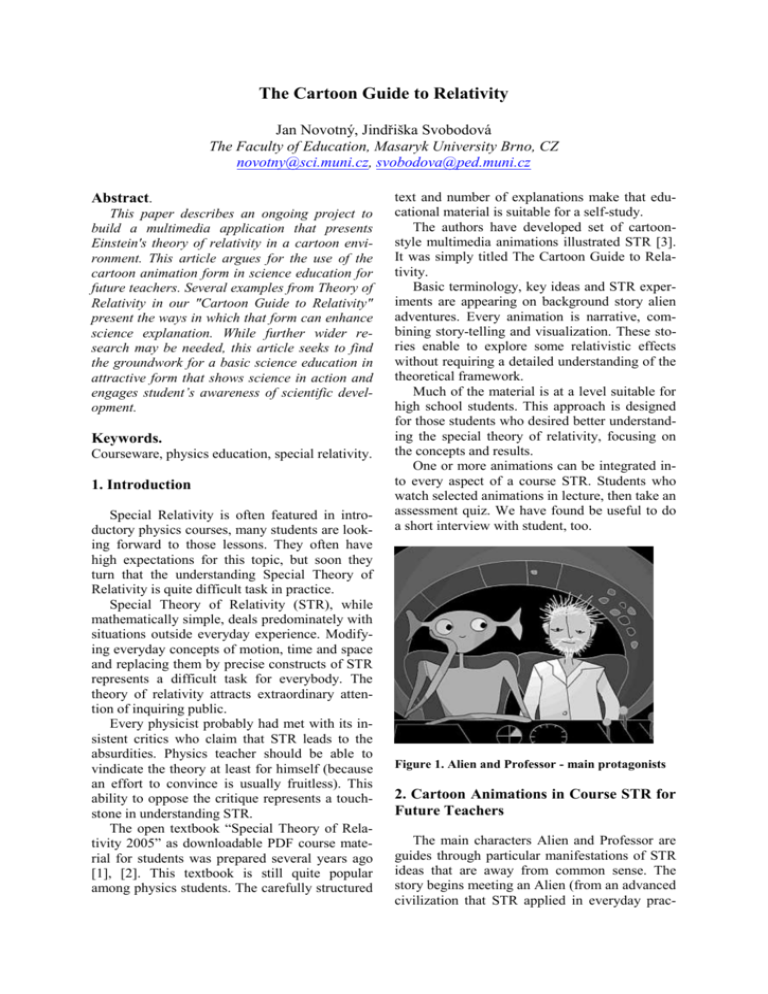
The Cartoon Guide to Relativity Jan Novotný, Jindřiška Svobodová The Faculty of Education, Masaryk University Brno, CZ novotny@sci.muni.cz, svobodova@ped.muni.cz Abstract. This paper describes an ongoing project to build a multimedia application that presents Einstein's theory of relativity in a cartoon environment. This article argues for the use of the cartoon animation form in science education for future teachers. Several examples from Theory of Relativity in our "Cartoon Guide to Relativity" present the ways in which that form can enhance science explanation. While further wider research may be needed, this article seeks to find the groundwork for a basic science education in attractive form that shows science in action and engages student’s awareness of scientific development. Keywords. Courseware, physics education, special relativity. 1. Introduction Special Relativity is often featured in introductory physics courses, many students are looking forward to those lessons. They often have high expectations for this topic, but soon they turn that the understanding Special Theory of Relativity is quite difficult task in practice. Special Theory of Relativity (STR), while mathematically simple, deals predominately with situations outside everyday experience. Modifying everyday concepts of motion, time and space and replacing them by precise constructs of STR represents a difficult task for everybody. The theory of relativity attracts extraordinary attention of inquiring public. Every physicist probably had met with its insistent critics who claim that STR leads to the absurdities. Physics teacher should be able to vindicate the theory at least for himself (because an effort to convince is usually fruitless). This ability to oppose the critique represents a touchstone in understanding STR. The open textbook “Special Theory of Relativity 2005” as downloadable PDF course material for students was prepared several years ago [1], [2]. This textbook is still quite popular among physics students. The carefully structured text and number of explanations make that educational material is suitable for a self-study. The authors have developed set of cartoonstyle multimedia animations illustrated STR [3]. It was simply titled The Cartoon Guide to Relativity. Basic terminology, key ideas and STR experiments are appearing on background story alien adventures. Every animation is narrative, combining story-telling and visualization. These stories enable to explore some relativistic effects without requiring a detailed understanding of the theoretical framework. Much of the material is at a level suitable for high school students. This approach is designed for those students who desired better understanding the special theory of relativity, focusing on the concepts and results. One or more animations can be integrated into every aspect of a course STR. Students who watch selected animations in lecture, then take an assessment quiz. We have found be useful to do a short interview with student, too. Figure 1. Alien and Professor - main protagonists 2. Cartoon Animations in Course STR for Future Teachers The main characters Alien and Professor are guides through particular manifestations of STR ideas that are away from common sense. The story begins meeting an Alien (from an advanced civilization that STR applied in everyday prac- tice) and Professor of theoretical physics. Alien traveling at high speed rocket informs Professor of his observations. All measurements and observations of natural phenomena are based on determining the spatial and temporal relations. Step by step they formulate the basic postulates of STR in their communication. I. All physical laws have the same form whatever constant velocity you are moving. II. The speed of light is always the same, independent of the motion of the observer or light source. Now, we describe several samples from our animation collections, listed below, with a brief description of its, we are using for this course STR. Then Alien explains a meaning of a word proper length to Professor. In classical mechanics, lengths are measured based on the assumption that the locations of all points involved are measured simultaneously, but in STR the notion of simultaneity is dependent on the observer. Proper length between two separated events is the distance between the two events, as measured in an inertial frame of reference in which the events are simultaneous. Proper lengths provide an invariant measure, whose value is the same for all observers. 2.2. Synchronization There is a new problem - synchronizing clocks at different points of space. In the course of analysis of the rocket motion the problem arises, how to determine simultaneous location of ends of rocket. A necessity turns out to synchronize distant clock. Alien presents to Professor his method of synchronization which in fact corresponds with Einstein’s method of exchange of light signals. 2.3. Composition of velocities Figure 2. Synchronisation method 2.1. Science Terms A conversation between Alien and a Professor begins by clarifying their terminology. The "event" means something quite specific in the context of STR: an event is something which happens at a single point in space at a single instant in time. The area of physical processes is a space-time, its elements are events. The processes in space-time are described from point of view of different frames of reference (we restrict ourselves on inertial systems of reference). Reference frame is idea of great importance. Key feature of both classical mechanics and STR is that no uniquely privileged reference frame exists. Any rigid non accelerating body may be regarded as a realization of the valid reference frame. In usual presentation of STR we restrict ourselves on inertial systems of reference (systems where the law inertial holds). The classical composition of velocities contradicts to the relativistic postulate of invariant velocity of light. Alien assign a task to Professor. You are monitoring a space ship moving away on Earth. If I am going at 0.5c relative to you and the rocket goes 0.5c relative to me how fast will it go relative to you? The results for classical and relativistic composition are presented. Figure 3. Adding velocities 2.4. Time Dilatation Alien shows to Professor how relativity implies time dilatation and length contraction. When object moves with relativistic speeds a "strange" thing seems to happen to its time as observed by "us" the stationary observer (observer in an inertial reference frame). In this story what we see happen is that the "clock" in motion (in train) slows down according to station clock, therefore we read two different times. Which time is correct? Well, they both are because time is not absolute but is relative, it depends on the reference frame. Figure 5. Professors attempt to measure length contraction 2.6. Twin Trip The twin paradox uses the symmetry of time dilation to produce a situation that seems paradoxical. The twin paradox is demonstrated as a story of two brothers born in the same time. The brothers go, one by one, the same cosmic travel and their biologic ages are contemporary separated and united again. Figure 4. The effect of time dilation The concept of simultaneity is analyzed in the case of door opening in the train moving with great velocity. It is demonstrated that relativistic simultaneity depends on the choice of reference system. 2.5. Length Contraction The dilatation of time, length contraction and they connection is represented here. Professor performs length contraction experiment with goat having a regular metabolism. He discovered that the length of object in a moving reference frame will appear foreshortened in the direction of motion, or contracted. It is shown that length between “marks” goat droppings is maximal from point of view of professor’s system of reference, whereas time interval of goat “marking” is minimal in the rocket system of reference. Figure 6. The twin traveling begins 3. Evaluation Continuous evaluation of textbook helped to identify implications for future directions. The students were satisfied with the reading level of a textbook and they welcomed further multimedia enlargement. The STR animation supplement is still evaluated through a combination of observation, interview and peer review. Besides, during semester students have completed surveys before and after performing multimedia animations. Students are required to watch selected animation (may be repeatedly) and than complete a series of test questions. At the end of every course, students solved simple problems from this field. In preparation for next semester the main features will be evaluated through peer review and with student test groups. Throughout the semester pre-tests and post-tests will be implemented to supplement the surveys and observations. 4. Conclusions The students, who have undertaken cartoon multimedia stories, have reported benefits in their understanding STR phenomena. They appreciated better visual representation for relativity ideas. In further refinement of these textbook and improved cartoon animations, authors will work on suggested modifications, worksheets and instructor notes of activities. They will introduce more explicit training documentation for STR tutors. Next research is now focusing on analysis the correlations of acquired student’s skills to other topics (geometry, attentiveness). Pre-test and post-test of students will provide an overview of the student’s concept development when experimenting with STR animation. 5. Acknowledgements Support for this study has been provided by EP project OPVK Moduly jako prostředek inovace v integraci výuky moderní fyziky a chemie reg. č.: CZ.1.07/2.2.00/28.0182. 6. References [1] Novotný J., Jurmanová J., Geršl J, Svobodová M. (2006) Základy teorie relativity. Elportál, Brno: MU. ISSN 1802-128X [2] Jurmanová J., Novotný J., Geršl J. (2006) Multimedia CD Úvod do speciální a obecné teorie relativity. Scientific Pedagogical Publishing, ISBN 80-85645-56-4. [3] STR Cartoon Project Website http://www.ped.muni.cz/wphy/C_R/cr.html [visited 30-Apr-2013] [4] Visualized Space Time Travel http://www.spacetimetravel.org/tompkins/ [visited 30-Apr-2013]
![[#PF-1998] subordintated taxa of Xenillidae](http://s3.studylib.net/store/data/007613529_2-36b265815b5d8ce7df1b35bae74e1254-300x300.png)
